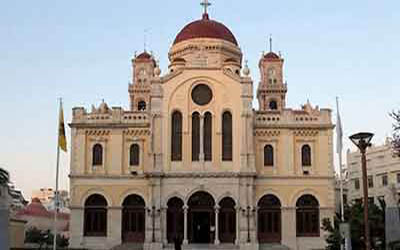
Cathedral of St. Minas
The Cathedral of Saint Minas is an Orthodox cathedral located in Heraklion and is the seat of the Archbishop of Crete. It was built on March 25, 1862 by the Metropolitan of Crete Dionysius of Adrianople Thrace. Its construction was interrupted during the Cretan Revolution of 1866 and finally completed at the beginning of 1895. The church was inaugurated on April 16, 1895 by Metropolitan Timothy I of Crete.The church is dedicated to Saint Minas, patron saint of Heraklion.The plan of the temple, as well as its housing, refer to the cruciform inscribed with a dome and high drum. Internally, it combines elements of a three-aisled basilica, with porches on the north, south and west sides of the P. The temple has a surface of 1,350 m2 and is the largest church in Crete and is considered (based on its basic sizes) and one one of the largest temples in Greece.

Agios Titos Church
The church of Saint Titus is an Orthodox church in Heraklion, Crete, dedicated to Saint Titus. The present church was built in 1869 as the Yeni Mosque and in 1925 was dedicated to Christian worship. The church was declared a cathedral of the Archdiocese of Crete in 2013. The building is an eclectic four-storey temple with a dome. On the outer side of the temple are the vertical elements, while on the top there is a sculptured inscription.The present building began to be constructed in 1869 under the design of Athanasios Mousi, who has designed, inter alia, the metropolitan church of Saint Minas. The new mosque became known as the Yeni Mosque, though it retained its old name. Following the accession of Crete to Greece and the exchange of populations, the building was repaired by the Church of Crete and dedicated to Orthodox Christian worship on May 3, 1925. The minaret of the mosque was demolished. On May 15, 1966 the temple of St. Titus from Venice was returned to the temple.From 1974 to 1988, the church was fortified and restored.In 2013, the church of Saint Titus was proclaimed by the Archbishop of Crete The Pacific Cathedral of the Archdiocese of Crete.
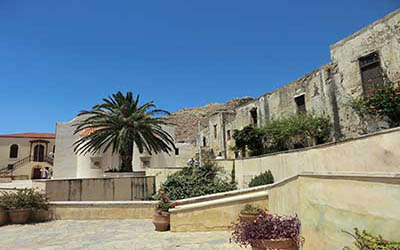
Preveli Monastery
On Crete's isolated south coast, built into a remote hillside overlooking the Libyan Sea, Preveli Monastery lies 36 kilometers south of Rethymnon and is only accessible via a winding road through the mountains. Dating from the 17th-century, the monastery features a church and a small museum displaying icons and ecclesiastical paraphernalia.Outside stands a Memorial for Peace and Resistance, erected in 2002. During the Battle of Crete, in 1941, the monks at Preveli gave supplies and shelter to the Allies. The monument is composed of a large headstone, with an unusual statue of a priest (holding a machine gun) and a soldier (one of the Allies) standing to each side. From here, you have absolutely stunning views down onto the sea.The drive to the monestary offers beautiful views over the south coast. You can combine a trip here with a stop at nearby Preveli Beach.Official site: http://www.preveli.org/files/moni/enindex.htm
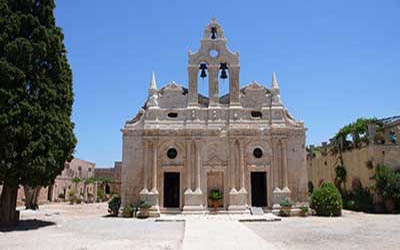
Arkadi Monastery
The Orthodox Church played an important role in liberating Greece from Turkish occupation. Set amid the rural foothills of Psiloritis (Mount Idi), 23 kilometers southeast of Rethymnon, this fortress-like 16th-century monastery is surrounded by high stone walls. Today, it's a wonderfully peaceful place, with a delightful Baroque church and a rose garden, but it has not always been so.In 1866, the monastery became the central meeting place for Cretan revolutionaries, with the Abbot as chairman. During an uprising against the Turks, some 900 locals (mainly women and children), who had taken refuge here, chose to blow themselves up rather than surrender. Outside the monastery, their skulls are displayed in glass cabinets as a haunting monument to their bravery.

The Monasteries of Akrotiri Peninsula
Agia Triada Monastery or the Monastery of Agia Triada Tsangarolon is a Greek Orthodox monastery in the Akrotiri peninsula in the Chania regional unit, Crete, Greece. It also contains a museum. The monastery, whose name means "Holy Trinity", was built in the 17th century by two brothers of the Venetian Zangaroli family on the site of a pre-existing church.The monks produce and sell wine and olive oil on the premises. A short drive away stands the fortress-like Gouverneto, founded in 1537. Even if the monastery is closed, the location is beautiful. From here, a footpath leads past Arkoudiospilia (Bear Cave), down 140 steps to Katholiko, an abandoned sixth-century monastery, built into a cliff face. After seeing the monasteries, head for Stavros Bay for a swim at the sandy beach where Anthony Quinn danced in the 1964 film Zorba the Greek.
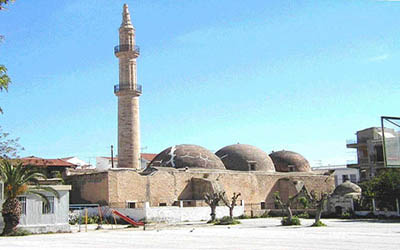
Neratze Mosque
Found near the center of town and easily recognized by its 27-meter-high minaret, is the Neratze Mosque, dating from 1600. No longer functioning as a religious building, it now hosts musical concerts. It is not open for tours, but be sure to have a look at the main doorway as you walk by. Out front is a large courtyard, and around the side you'll find pleasant cafés in the shadow of the walls.
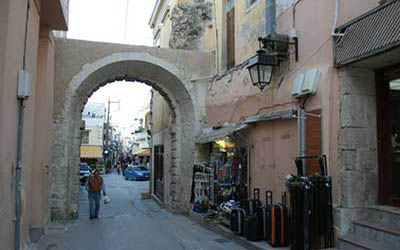
Porta Guora
Located at the south end of the old town, this is the only remaining structure from the 16th-century walls. Arching over the narrow street below, this landmark is an ideal place to start your visit to the old town.If you continue straight down this main road, you'll pass by some of the highlights of the old town, including the Rimondi Fountain. Porta Guora also goes by the name of Great Gate of Reythmnon.
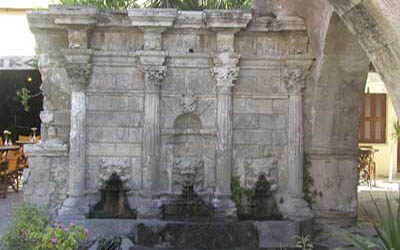
Rimondi Fountain
This fountain dates from the early 15th and once supplied the entire drinking water supply for the city during Venetian times, and today the water is potable, so fill up your water bottle from an ancient source.The fountain is set in Platanou square, a shady spot surrounded by shops and café.


